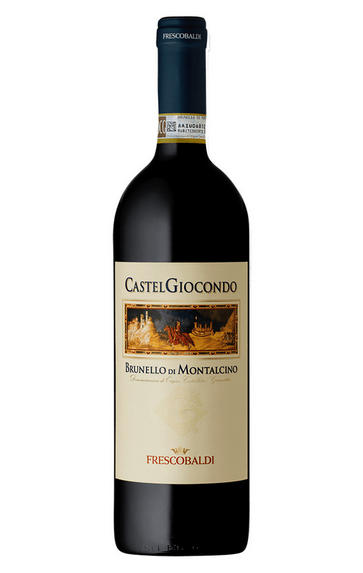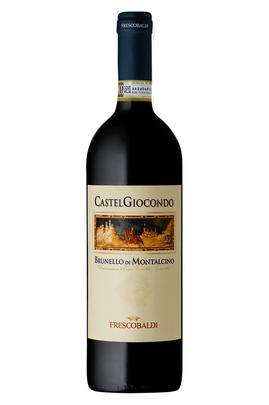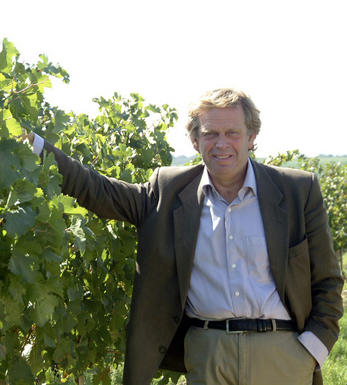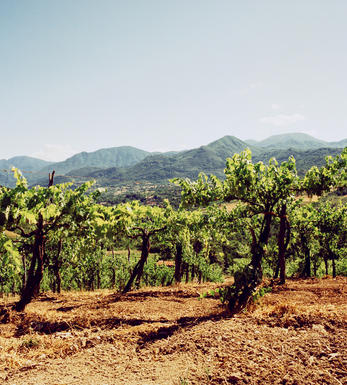
2016 Brunello di Montalcino, CastelGiocondo, Frescobaldi, Tuscany, Italy

Critics reviews
Sour cherries, spiced orange and dusty dried flowers open in the glass, as the 2016 Castelgiocondo Brunello di Montalcino slowly blossoms. The textures are creamy, contrasted by cooling minerality and juicy acids, as tart red berries saturate under an air of sweet herbs and inner florals. This finishes dry yet long, with chewy tannins and remnants of crunchy red fruit. The 2016 Castelgiocondo needs some time to come together, yet it has all of the balance necessary to mature into a real beauty. Drink 2026-2038
Eric Guido, vinous.com (Nov 2020)
Drink 2022 to 2036
Jane Anson, Inside Bordeaux (October 2021)
The Frescobaldi 2016 Brunello di Montalcino CastelGiocondo shows dark fruit, plum and spice. The wine offers good density and richness, but the aromatic intensity is downplayed compared to some of its peers from this classic vintage. Other than that, all the wine's elements are in the right place with cherry, wild plum, rose and tilled earth. Drink 2023-2038.
Monica Larner, Wine Advocate (Nov 2020)
Black-cherry and blackberry aromas with minerals and fresh flowers, following through to a full body with firm, silky tannins that are polished and intense. Lovely finesse and length. Drink after 2023.
James Suckling, jamessuckling.com (Nov 2020)
About this WINE

Marchesi De Frescobaldi
Marchesi di Frescobaldi, one of the oldest Italian wine companies and the largest, is something of a paradox. The company which owns nearly 1000 hectares of vineyard land in Tuscany remains in the control of one family which, while it traces its history back at least seven centuries, has also consistently been at the forefront of the modernisation of the Italian wine industry. The family has been producing wine since 1300 and produces an exemplary range of wines from its estates at Castello di Nipozzano, Pomino and CastelGiocondo.
Tenuta CastelGiocondo is one of the original Brunello estates, originally an ancient stronghold built in 1100. One of the first four properties to produce Brunello di Montalcino in 1800, it has been owned by Frescobaldi since 1989. Named after an ancient castle and a small medieval village to the south-west of Montalcino, CastelGiocondo hosts an ideal terroir for high-quality Sangiovese.
The 151-hectare estate is home to a unique combination of soils, altitudes and microclimates, which allow the grapes to grow with delicacy, balance and harmony. The soils vary by altitude, with clay at 250 metres; well-drained sandstone at 300 metres; and the high-quality galestro soils at 350-450 metres – where the best Sangiovese for the Brunello and Ripe al Convento are grown. While not officially certified, the estate has been farmed organically since 2013, working with the greatest respect for the terroir and land surrounding them.
The Frescobladis` links with the Mondavi family in California have resulted in the joint purchase of a estate in Montalcino adjacent to Castelgiocondo to produce the company's flagship wine - Luce. The Luce site was selected for its potential to produce the very best fruit and there is no compromise in its winemaking or its viticultural care. It represents the very best that the company can produce. The company also produces the Lucetta, a wine from a blend of the very best parcels of fruit from all the company's Tuscany vineyards. Both wines contain Merlot as well as the traditional Sangiovese.

Brunello di Montalcino
Along with Chianti, Brunello di Montalcino is Tuscany's most famous DOCG and the region's boldest expression of Sangiovese. Located 30 miles south of Siena with the hilltop town of Montalcino as its epicentre, its 2,000 hectares of vines are naturally delimited by the Orcia, Asso and Ombrone valleys. Brunello is the local name for the Sangiovese Grosso clone from which Brunello di Montalcino should be made in purezza (ie 100 percent).
The Brunello di Montalcino DOCG has a whale-like shape: at its head, at 661 metres above sea level on ancient, stony galestro soils facing east and southeast lies the town of Montalcino, where the DOC was founded. As you follow the spine south towards the tail, the vineyards lose altitude – those around Colle Sant'Angelo are at 250 metres – while the soils become richer with iron and clay. Further east, in the shadow of the 1,734 metre Mont'Amiata lies the village of Castelnuovo dell'Abate where the vineyards are strewn with a rich mix of galestro, granitic, volcanic, clay and schist soil types.
Historically, the zone is one of Tuscany's youngest. First praised in 1550 by Leandro Alberti for the quality of its wines, it was Tenuta Il Greppo who bottled the inaugural Brunello di Montalcino in 1888. By 1929, the region had 925 hectares of vines and 1,243 hectares of mixed crops, while in 1932 it was decreed that only those wines made and bottled within the commune could be labelled as Brunello di Montalcino. Since then, the number of producers has risen from 11 in 1960 to 230 in 2006, while over the same period the vineyards have expanded from 1,000 hectares to 12,000. The region earned its DOC in 1966, and was upgraded to DOCG in 1980.
Brunello di Montalcino cannot be released for sale until five years after the harvest, or six years in the case of Brunello di Montalcino Riserva. During this time the wines should be aged for at least two years in oak, followed by at least four months in bottle (six months for Riservas); maximum yields are 55 hl/ha.
Rosso di Montalcino is declassified Brunello di Montalcino, released for sale 18 months after the harvest.
Recommended producers: Costanti, Fuligni, Lisini, San Giuseppe, Soldera, Cerbaiona

Sangiovese
A black grape widely grown in Central Italy and the main component of Chianti and Vino Nobile di Montepulciano as well as being the sole permitted grape for the famed Brunello di Montalcino.
It is a high yielding, late ripening grape that performs best on well-drained calcareous soils on south-facing hillsides. For years it was blighted by poor clonal selection and massive overcropping - however since the 1980s the quality of Sangiovese-based wines has rocketed upwards and they are now some of the most sought after in the world.
It produces wines with pronounced tannins and acidity, though not always with great depth of colour, and its character can vary from farmyard/leather nuances through to essence of red cherries and plums. In the 1960s the advent of Super Tuscans saw bottlings of 100% Sangiovese wines, as well as the introduction of Sangiovese/Cabernet Sauvignon blends, the most famous being Tignanello.


Buying options
Add to wishlist
Description
Black cherry, sour plum and dried roses open and excite on the nose. The palate is polished, glossy fruit and unctuous in texture. Ripe berries, soft red and black fruits, spices and wild herbs fill and punctuate the palate. As with all the great wines of 2016, the tannins are firm, but with silky chew, softened by the cappuccino notes of oak. There is a vivid, tightly coiled freshness, which extends the enjoyment and length. The final notes are woven with minerality. This is deserving of time. Drink 2025-2040.
Davy Zyw, Senior Buyer (May 2020)
wine at a glance
Delivery and quality guarantee